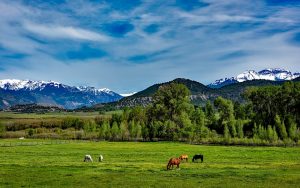
QUESTION:
My wife and I were out riding over the weekend, and are relatively new to horses and her horse tripped and fell to her knees. The mare stood up quickly, and walked out of it ok. There were a couple of skinned areas on her knees and ankles, but nothing appeared significant. When we got home we cleaned her up as well as we could. We asked our friends what we should keep with us on the trail? I think that we have a pretty good list, but would like your input.
ANSWER:
When deciding what first aid items should come with you, consider the terrain you will be riding in, how far you will be from the trailhead/barn and the possible “emergencies” that could arise for your horse.
One of the most common injuries on the trail is a laceration- from a small scratch to a significant cut. As veterinarians, we’ve seen the full spectrum of wounds coming in from a trail ride, and they can happen from head to toe. When dealing with a laceration, the first step is to control bleeding. If you are carrying at least some basic bandage materials (which is never a bad idea) including sterile pads, some roll cotton, and some vet wrap, you can apply a pressure bandage. Call us about the varying bandaging techniques used on the horse’s oddly shaped legs. The bandage will also help with the second most important goal of wound care, keeping the wound clean until you can get your horse to the vet, or a vet to him.
No matter the terrain, there is always the possibility of colic with a horse. Dehydration can be a risk factor for colic. Decreased water intake prior to a ride, a significant amount of physical exertion, and even the length between drinks can cause dehydration in your horse. While not every dehydrated working horse experiences colic, the longer that they are dehydrated, the more likely colic is to occur. If your horse doesn’t drink well away from home, or frets on the trailer, using paste electrolytes to increase his desire to drink before the ride, will help him to “tank up”, as well as keeping his electrolyte loss minimized. Knowing your horses’ fitness level and his ability level will help prevent overworking your horse. Again, if you know your horse is going to exercise more than normal, electrolytes can help prevent an issue. Ask us about whether or not you should have a dose of Banamine (Flunixin Meglumine) with you on longer trail rides or overnight pack trips.
One other piece of a trail first aid kit is a section of old garden hose about 12 inches in length. This odd piece of “first aid” equipment is in the event that you and your horse run across a rattlesnake. It may seem strange, but the most common spot for a horse to be bitten by a rattlesnake is on the nose. The horse is usually trying to figure out what was making all of that noise. The horse’s nose will begin to swell, and can eventually reduce the amount of air he can more through the nose, to the point of suffocation. That’s when the garden hose comes in handy- the horse may not be happy about it, but it may save his life. If you are not familiar with what to do, be sure to ask us about how to properly use this technique.
The goals of first aid on the trail range from keeping a scratch clean to potentially stabilizing your horse until professional help can be obtained. As with many situations, a little first aid forethought and preparation can help your horse, and possibly even save their life. We have found that the following things can be a good starting point for a first aid kit, but feel free to ask us about what works best for your situation.
- First Aid Kit
- Stethoscope
- Thermometer
- Bandage Scissors
- Flashlight/headlamp
- 4×4 gauze pads (20-50)
- Sheet or Roll cotton
- 6” gauze roll
- 3” or 4” Elastikon roll (1 or 2)
- Vet wrap
- Telfa (non-stick) pads
- Plastic cup
- Anti-bacterial hand soap or Anti-septic soap
- Anti-bacterial first aid ointment (Neosporin or similar)
- 12” length of garden hose





1 Comment
[…] From a veterinary standpoint, there are certainly some fairly common issues that arise on the trail. The most common are lacerations, cuts or abrasions. Having a small bandage kit and antiseptic should cover most of these, and certainly enable you to get to help for treatment of more significant lacerations. A good bandage kit should include betadine, sterile pads, gauze, cotton wrap, vetwrap and elasticon. If you are not comfortable with bandaging your horse, any of us here at Mobile Vet will be happy to show you how. For more in-depth information on what should be in a good trail first aid kit, see our blog post “Trail First Aid. What Do I Need?” […]